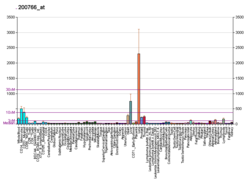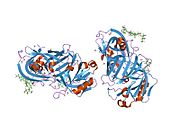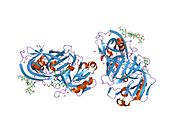Cathepsin D
Cathepsin D is a protein that in humans is encoded by the CTSD gene.[5][6] This gene encodes a lysosomal aspartyl protease composed of a protein dimer of disulfide-linked heavy and light chains, both produced from a single protein precursor. Cathepsin D is an aspartic endo-protease that is ubiquitously distributed in lysosomes.[7] The main function of cathepsin D is to degrade proteins and activate precursors of bioactive proteins in pre-lysosomal compartments.[8] This proteinase, which is a member of the peptidase A1 family, has a specificity similar to but narrower than that of pepsin A. Transcription of the CTSD gene is initiated from several sites, including one that is a start site for an estrogen-regulated transcript. Mutations in this gene are involved in the pathogenesis of several diseases, including breast cancer and possibly Alzheimer disease.[6] Homozygous deletion of the CTSD gene leads to early lethality in the postnatal phase.[9] Deficiency of CTSD gene has been reported an underlying cause of neuronal ceroid lipofuscinosis (NCL).[10]
Structure[edit]
Gene[edit]
The CTSD gene is located at chromosome 11.
Protein[edit]
The catalytic sites of cathepsin D include two critical aspartic residues (amino acid 33 and 231) located on the 14 kDa and 34kDa chains.[11] The ultimate form of mature cathepsin D is composed of 337 amino acid residues, 196 amino acid residues in the heavy chain and 141 in the light chain. These two chains are linked by the hydrophobic effect.[12]
Function[edit]
The optimum pH for cathepsin D in vitro is 4.5-5.0.[13] Cathepsin-D is an aspartic protease that depends critically on protonation of its active site Asp residue. Along with Asp-protonation, lower pH also leads to conformational switch in cathepsin-D : the N-terminal segment of the protease moves out of the active site as pH drops.[14][15][16] Similar to other aspartic proteases, cathepsin D accommodates up to 8 amino acid residues in the binding cleft of the active site. The main physiological functions of cathepsin D consist of metabolic degradation of intracellular proteins, activation and degradation of polypeptide hormones and growth factors, activation of enzymatic precursors, processing of enzyme activators and inhibitors, brain antigen processing and regulation of programmed cell death.[17][18][19][20] Cathepsin D can also be found in the extracellular space[20] and it is one of the few cathepsins, that shows some activity at neutral pH.[21] It is able to activate the growth factors VEGF-C and VEGF-D, which might partly explain its relevance for tumor progression.[22]
Clinical significance[edit]
The NCLs present with progressive loss of visual function and neurodevelopmental decline, seizure, myoclonic jerks and premature death. The CTSD gene is one of the identified eight genes the deficiency of which is responsible for NCLs.[10] It has been reported that a homozygous single nucleotide duplication in exon 6 could alter the reading frame and causes a premature stop codon at position 255. Over-expression of cathepsin D stimulates tumorigenicity and metastasis as well as initiation of tumor apoptosis. This protease has been regarded an independent marker of poor prognosis in breast cancer being correlated with the incidence of clinical metastasis.[23][24] Knock-out of CTSD gene would cause intestinal necrosis and hemorrhage and increase apoptosis in thymus, indicating that cathepsin D is required in certain epithelial cells for tissue remodeling and renewal.[9] It is also reported that there might be a strong effect for CTSD genotype on Alzheimer disease risk in male.[25] Cathepsin D enzymatic activity induces hydrolytic modification of apolipoprotein B-100-containing lipoproteins, including LDL, which means it may be involved in atherosclerosis as well.[18][26]
Interaction[edit]
References[edit]
- ^ a b c GRCh38: Ensembl release 89: ENSG00000117984 – Ensembl, May 2017
- ^ a b c GRCm38: Ensembl release 89: ENSMUSG00000007891 – Ensembl, May 2017
- ^ "Human PubMed Reference:". National Center for Biotechnology Information, U.S. National Library of Medicine.
- ^ "Mouse PubMed Reference:". National Center for Biotechnology Information, U.S. National Library of Medicine.
- ^ Faust PL, Kornfeld S, Chirgwin JM (August 1985). "Cloning and sequence analysis of cDNA for human cathepsin D". Proceedings of the National Academy of Sciences of the United States of America. 82 (15): 4910–4. Bibcode:1985PNAS...82.4910F. doi:10.1073/pnas.82.15.4910. PMC 390467. PMID 3927292.
- ^ a b "Entrez Gene: CTSD cathepsin D".
- ^ Barrett AJ (April 1970). "Cathepsin D. Purification of isoenzymes from human and chicken liver". The Biochemical Journal. 117 (3): 601–7. doi:10.1042/bj1170601. PMC 1178965. PMID 5419752.
- ^ Diment S, Martin KJ, Stahl PD (August 1989). "Cleavage of parathyroid hormone in macrophage endosomes illustrates a novel pathway for intracellular processing of proteins". The Journal of Biological Chemistry. 264 (23): 13403–6. doi:10.1016/S0021-9258(18)80010-2. PMID 2760027.
- ^ a b Saftig P, Hetman M, Schmahl W, Weber K, Heine L, Mossmann H, Köster A, Hess B, Evers M, von Figura K (August 1995). "Mice deficient for the lysosomal proteinase cathepsin D exhibit progressive atrophy of the intestinal mucosa and profound destruction of lymphoid cells". The EMBO Journal. 14 (15): 3599–608. doi:10.1002/j.1460-2075.1995.tb00029.x. PMC 394433. PMID 7641679.
- ^ a b Ramirez-Montealegre D, Rothberg PG, Pearce DA (June 2006). "Another disorder finds its gene". Brain. 129 (Pt 6): 1353–6. doi:10.1093/brain/awl132. PMID 16738059.
- ^ Metcalf P, Fusek M (April 1993). "Two crystal structures for cathepsin D: the lysosomal targeting signal and active site". The EMBO Journal. 12 (4): 1293–302. doi:10.1002/j.1460-2075.1993.tb05774.x. PMC 413340. PMID 8467789.
- ^ Minarowska A, Gacko M, Karwowska A, Minarowski Ł (2008). "Human cathepsin D". Folia Histochemica et Cytobiologica / Polish Academy of Sciences, Polish Histochemical and Cytochemical Society. 46 (1): 23–38. doi:10.2478/v10042-008-0003-x. PMID 18296260.
- ^ Briozzo P, Morisset M, Capony F, Rougeot C, Rochefort H (July 1988). "In vitro degradation of extracellular matrix with Mr 52,000 cathepsin D secreted by breast cancer cells". Cancer Research. 48 (13): 3688–92. PMID 3378211.
- ^ Authier F, Metioui M, Fabrega S, Kouach M, Briand G (March 2002). "Endosomal proteolysis of internalized insulin at the C-terminal region of the B chain by cathepsin D". The Journal of Biological Chemistry. 277 (11): 9437–46. doi:10.1074/jbc.M110188200. PMID 11779865.
- ^ Lee AY, Gulnik SV, Erickson JW (October 1998). "Conformational switching in an aspartic proteinase". Nature Structural Biology. 5 (10): 866–71. doi:10.1038/2306. PMID 9783744. S2CID 5685201.
- ^ Petsko G, Ringe D (2004). Protein Structure and Function. Oxford [England]; Sunderland, MA; New York: Oxford University Press. ISBN 978-1-4051-1922-1.
- ^ Baechle D, Flad T, Cansier A, Steffen H, Schittek B, Tolson J, et al. (March 2006). "Cathepsin D is present in human eccrine sweat and involved in the postsecretory processing of the antimicrobial peptide DCD-1L". The Journal of Biological Chemistry. 281 (9): 5406–15. doi:10.1074/jbc.M504670200. PMID 16354654.
- ^ a b Hakala JK, Oksjoki R, Laine P, Du H, Grabowski GA, Kovanen PT, Pentikäinen MO (August 2003). "Lysosomal enzymes are released from cultured human macrophages, hydrolyze LDL in vitro, and are present extracellularly in human atherosclerotic lesions". Arteriosclerosis, Thrombosis, and Vascular Biology. 23 (8): 1430–6. doi:10.1161/01.ATV.0000077207.49221.06. PMID 12750117.
- ^ Bańkowska A, Gacko M, Chyczewska E, Worowska A (1997). "Biological and diagnostic role of cathepsin D". Roczniki Akademii Medycznej W Białymstoku. 42 (Suppl 1): 79–85. PMID 9337526.
- ^ a b Benes P, Vetvicka V, Fusek M (October 2008). "Cathepsin D—many functions of one aspartic protease". Critical Reviews in Oncology/Hematology. 68 (1): 12–28. doi:10.1016/j.critrevonc.2008.02.008. PMC 2635020. PMID 18396408.
- ^ Lkhider M, Castino R, Bouguyon E, Isidoro C, Ollivier-Bousquet M (October 2004). "Cathepsin D released by lactating rat mammary epithelial cells is involved in prolactin cleavage under physiological conditions". Journal of Cell Science. 117 (Pt 21): 5155–64. doi:10.1242/jcs.01396. PMID 15456852.
- ^ Jha, Sawan Kumar; Rauniyar, Khushbu; Chronowska, Ewa; Mattonet, Kenny; Maina, Eunice Wairimu; Koistinen, Hannu; Stenman, Ulf-Håkan; Alitalo, Kari; Jeltsch, Michael (2019-05-17). "KLK3/PSA and cathepsin D activate VEGF-C and VEGF-D". eLife. 8: –44478. doi:10.7554/eLife.44478. ISSN 2050-084X. PMC 6588350. PMID 31099754.
- ^ Traynor JP, Oun HA, McKenzie P, Shilliday IR, McKay IG, Dunlop A, Geddes CC, Mactier RA (November 2005). "Assessing the utility of the stop dialysate flow method in patients receiving haemodiafiltration". Nephrology, Dialysis, Transplantation. 20 (11): 2479–84. doi:10.1093/ndt/gfi021. PMID 16046508.
- ^ Wolf M, Clark-Lewis I, Buri C, Langen H, Lis M, Mazzucchelli L (April 2003). "Cathepsin D specifically cleaves the chemokines macrophage inflammatory protein-1 alpha, macrophage inflammatory protein-1 beta, and SLC that are expressed in human breast cancer". The American Journal of Pathology. 162 (4): 1183–90. doi:10.1016/S0002-9440(10)63914-4. PMC 1851240. PMID 12651610.
- ^ Menzer G, Müller-Thomsen T, Meins W, Alberici A, Binetti G, Hock C, Nitsch RM, Stoppe G, Reiss J, Finckh U (March 2001). "Non-replication of association between cathepsin D genotype and late onset Alzheimer disease". American Journal of Medical Genetics. 105 (2): 179–82. doi:10.1002/ajmg.1204. PMID 11304834.
- ^ Haidar B, Kiss RS, Sarov-Blat L, Brunet R, Harder C, McPherson R, Marcel YL (December 2006). "Cathepsin D, a lysosomal protease, regulates ABCA1-mediated lipid efflux". The Journal of Biological Chemistry. 281 (52): 39971–81. doi:10.1074/jbc.M605095200. PMID 17032648.
- ^ Umezawa H, Aoyagi T, Morishima H, Matsuzaki M, Hamada M (May 1970). "Pepstatin, a new pepsin inhibitor produced by Actinomycetes". The Journal of Antibiotics. 23 (5): 259–62. doi:10.7164/antibiotics.23.259. PMID 4912600.
- ^ Kim SJ, Kim KH, Ahn ER, Yoo BC, Kim SY (January 2013). "Depletion of cathepsin D by transglutaminase 2 through protein cross-linking promotes cell survival". Amino Acids. 44 (1): 73–80. doi:10.1007/s00726-011-1089-6. PMID 21960143. S2CID 17149825.
- ^ Devosse T, Dutoit R, Migeotte I, De Nadai P, Imbault V, Communi D, Salmon I, Parmentier M (August 2011). "Processing of HEBP1 by cathepsin D gives rise to F2L, the agonist of formyl peptide receptor 3". Journal of Immunology. 187 (3): 1475–85. doi:10.4049/jimmunol.1003545. PMID 21709160.
- ^ Mariani E, Seripa D, Ingegni T, Nocentini G, Mangialasche F, Ercolani S, Cherubini A, Metastasio A, Pilotto A, Senin U, Mecocci P (September 2006). "Interaction of CTSD and A2M polymorphisms in the risk for Alzheimer's disease". Journal of the Neurological Sciences. 247 (2): 187–91. doi:10.1016/j.jns.2006.05.043. PMID 16784755. S2CID 34224448.
- ^ Heinrich M, Wickel M, Schneider-Brachert W, Sandberg C, Gahr J, Schwandner R, Weber T, Saftig P, Peters C, Brunner J, Krönke M, Schütze S (October 1999). "Cathepsin D targeted by acid sphingomyelinase-derived ceramide". The EMBO Journal. 18 (19): 5252–63. doi:10.1093/emboj/18.19.5252. PMC 1171596. PMID 10508159.
Further reading[edit]
- Chao J, Miao RQ, Chen V, Chen LM, Chao L (January 2001). "Novel roles of kallistatin, a specific tissue kallikrein inhibitor, in vascular remodeling". Biological Chemistry. 382 (1): 15–21. doi:10.1515/BC.2001.003. PMID 11258665. S2CID 33204682.
- Leto G, Tumminello FM, Crescimanno M, Flandina C, Gebbia N (2004). "Cathepsin D expression levels in nongynecological solid tumors: clinical and therapeutic implications". Clinical & Experimental Metastasis. 21 (2): 91–106. doi:10.1023/B:CLIN.0000024740.44602.b7. PMID 15168727. S2CID 3476324.
- Liaudet-Coopman E, Beaujouin M, Derocq D, Garcia M, Glondu-Lassis M, Laurent-Matha V, Prébois C, Rochefort H, Vignon F (June 2006). "Cathepsin D: newly discovered functions of a long-standing aspartic protease in cancer and apoptosis". Cancer Letters. 237 (2): 167–79. doi:10.1016/j.canlet.2005.06.007. PMID 16046058. S2CID 41309909.
- Knight CG, Barrett AJ (April 1976). "Interaction of human cathepsin D with the inhibitor pepstatin". The Biochemical Journal. 155 (1): 117–25. doi:10.1042/bj1550117. PMC 1172808. PMID 938470.
- Gulnik S, Baldwin ET, Tarasova N, Erickson J (September 1992). "Human liver cathepsin D. Purification, crystallization and preliminary X-ray diffraction analysis of a lysosomal enzyme". Journal of Molecular Biology. 227 (1): 265–70. doi:10.1016/0022-2836(92)90696-H. PMID 1522590.
- Conner GE, Richo G (February 1992). "Isolation and characterization of a stable activation intermediate of the lysosomal aspartyl protease cathepsin D". Biochemistry. 31 (4): 1142–7. doi:10.1021/bi00119a024. PMID 1734961. S2CID 3014149.
- Fujita H, Tanaka Y, Noguchi Y, Kono A, Himeno M, Kato K (August 1991). "Isolation and sequencing of a cDNA clone encoding rat liver lysosomal cathepsin D and the structure of three forms of mature enzymes". Biochemical and Biophysical Research Communications. 179 (1): 190–6. doi:10.1016/0006-291X(91)91353-E. PMID 1883350.
- Dunn AD, Crutchfield HE, Dunn JT (October 1991). "Thyroglobulin processing by thyroidal proteases. Major sites of cleavage by cathepsins B, D, and L". The Journal of Biological Chemistry. 266 (30): 20198–204. doi:10.1016/S0021-9258(18)54909-7. PMID 1939080.
- Lenarcic B, Krasovec M, Ritonja A, Olafsson I, Turk V (March 1991). "Inactivation of human cystatin C and kininogen by human cathepsin D". FEBS Letters. 280 (2): 211–5. doi:10.1016/0014-5793(91)80295-E. PMID 2013314. S2CID 23798502.
- Redecker B, Heckendorf B, Grosch HW, Mersmann G, Hasilik A (1991). "Molecular organization of the human cathepsin D gene". DNA and Cell Biology. 10 (6): 423–31. doi:10.1089/dna.1991.10.423. PMID 2069717.
- Conner GE, Udey JA (1990). "Expression and refolding of recombinant human fibroblast procathepsin D". DNA and Cell Biology. 9 (1): 1–9. doi:10.1089/dna.1990.9.1. PMID 2180427.
- Capony F, Rougeot C, Montcourrier P, Cavailles V, Salazar G, Rochefort H (July 1989). "Increased secretion, altered processing, and glycosylation of pro-cathepsin D in human mammary cancer cells". Cancer Research. 49 (14): 3904–9. PMID 2736531.
- Lenarcic B, Kos J, Dolenc I, Lucovnik P, Krizaj I, Turk V (July 1988). "Cathepsin D inactivates cysteine proteinase inhibitors, cystatins". Biochemical and Biophysical Research Communications. 154 (2): 765–72. doi:10.1016/0006-291X(88)90206-9. PMID 3261170.
- Westley BR, May FE (May 1987). "Oestrogen regulates cathepsin D mRNA levels in oestrogen responsive human breast cancer cells". Nucleic Acids Research. 15 (9): 3773–86. doi:10.1093/nar/15.9.3773. PMC 340781. PMID 3588310.
- Terayama H, Fukuzumi R (1987). "Ubiquitous presence of calciferin-like and cathepsin D-like activities in the sera (vertebrates) and humoral fluids (invertebrates)". Comparative Biochemistry and Physiology. B, Comparative Biochemistry. 87 (4): 675–9. doi:10.1016/0305-0491(87)90373-7. PMID 3665421.
- Sekiguchi K, Siri A, Zardi L, Hakomori S (April 1985). "Differences in domain structure between human fibronectins isolated from plasma and from culture supernatants of normal and transformed fibroblasts. Studies with domain-specific antibodies". The Journal of Biological Chemistry. 260 (8): 5105–14. doi:10.1016/S0021-9258(18)89185-2. PMID 3988746.
- Lemansky P, Gieselmann V, Hasilik A, von Figura K (August 1984). "Cathepsin D and beta-hexosaminidase synthesized in the presence of 1-deoxynojirimycin accumulate in the endoplasmic reticulum". The Journal of Biological Chemistry. 259 (16): 10129–35. doi:10.1016/S0021-9258(18)90939-7. PMID 6236213.
- Dreyer RN, Bausch KM, Fracasso P, Hammond LJ, Wunderlich D, Wirak DO, Davis G, Brini CM, Buckholz TM, König G (September 1994). "Processing of the pre-beta-amyloid protein by cathepsin D is enhanced by a familial Alzheimer's disease mutation". European Journal of Biochemistry. 224 (2): 265–71. doi:10.1111/j.1432-1033.1994.00265.x. PMID 7523115.
- Atkins KB, Troen BR (July 1995). "Regulation of cathepsin D gene expression in HL-60 cells by retinoic acid and calcitriol". Cell Growth & Differentiation. 6 (7): 871–7. PMID 7547509.
External links[edit]
- The MEROPS online database for peptidases and their inhibitors: A01.009 Archived 2008-04-02 at the Wayback Machine
- GeneReviews/NIH/NCBI/UW entry on Neuronal Ceroid-Lipofuscinoses
- PDBe-KB provides an overview of all the structure information available in the PDB for Human Cathepsin D










